Neurological Research Institute at Texas Children’s Hospital Building Receives LEED Gold
 HOUSTON, Texas –The building created to house the Jan and Dan Duncan Neurological Research Institute at Texas Children’s Hospital, one of the world’s first basic research institutes dedicated to childhood neurological diseases, has been awarded LEED Gold certification by the U.S. Green Building Council.
HOUSTON, Texas –The building created to house the Jan and Dan Duncan Neurological Research Institute at Texas Children’s Hospital, one of the world’s first basic research institutes dedicated to childhood neurological diseases, has been awarded LEED Gold certification by the U.S. Green Building Council.
- Opened in December 2010, the 13-story NRI facility was designed and constructed to incorporate the key principles of LEED and using strategies aimed at achieving high performance in key areas of human and environmental health. In particular, the NRI building incorporates several sustainable laboratory design strategies, a noteworthy feature given that research laboratories are high energy users.
“We are very proud of our LEED-certified research building and commend our architectural firm Perkins+Will, and our contractor, Tellepsen, for achieving the sustainable, functional and aesthetically pleasing facility that we all envisioned,” said Dr. Huda Zoghbi, director of the NRI at Texas Children’s Hospital and professor of neurology, neuroscience, pediatrics, and molecular and human genetics at Baylor College of Medicine. “The NRI building provides our multidisciplinary team with a facility that both meets our scientific needs and reflects our shared focus on collaboration with each other and with the world around us.”
Ray Beets, FAIA, principal of Perkins+Will, said the NRI was evaluated in five key categories including sustainable sites, energy and atmosphere, materials and resources, indoor environmental quality, and innovation and design.
“This LEED certification provides independent, third-party verification that the NRI is an environmentally responsible and healthy place to conduct its leading-edge research,” said Beets. “Effective sustainable design is not achieved by simply including an energy efficiency component, but by infusing design strategies that consider resources, climate and functionality from the very beginning of design and construction.”
Many sustainable features of the building have provided a healthful, comfortable working environment and deliver significant energy and maintenance cost savings. The building achieves 35-percent energy reduction off the baseline for lab buildings with the use of innovative demand-controlled ventilation. Creative planning and a comprehensive daylight harvesting system provide 98.5-percent daylight to all regularly occupied spaces.
In addition to its sustainable features, the NRI building was designed to facilitate the institute’s pioneering multidisciplinary research approach. To help speed discoveries in the complex study of brain development and function, NRI researchers work in specially designed “collaboratories,” open labs that facilitate the free exchange of ideas, information and resources.
For more information about the Jan and Dan Duncan Neurological Research Institute at Texas Children’s Hospital, visit www.nri.texaschildrens.org.
Posted February 14, 2012
More Articles:
- CxA Workshop & Exam
Apr 29, 2024 – Apr 30, 2024 - EMP Seminar & Exam at CxEnergy 2024
Apr 29, 2024 – Apr 30, 2024 - CxEnergy
Apr 29, 2024 – May 2, 2024 - PHCC West 2024
Apr 29, 2024 – May 2, 2024 - Lean in Design Forum 2024
May 1, 2024 – May 2, 2024 - IFMA’s Facility Fusion Conference & Expo
May 5, 2024 – May 7, 2024 - ASHE Academy 2024
May 6, 2024 – May 10, 2024










